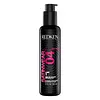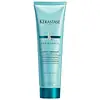What's inside
What's inside
 Key Ingredients
Key Ingredients

No key ingredients
 Benefits
Benefits

 Concerns
Concerns

 Ingredients Side-by-side
Ingredients Side-by-side

Water
Skin ConditioningPropylene Glycol
HumectantDimethicone
EmollientAmodimethicone
Isopropyl Myristate
EmollientTriethanolamine
BufferingPhenoxyethanol
PreservativeParfum
MaskingPEG-40 Hydrogenated Castor Oil
EmulsifyingPEG/PPG-17/18 Dimethicone
EmulsifyingCarbomer
Emulsion StabilisingPolyquaternium-4
Polyquaternium-6
Potato Starch Modified
Hydroxypropyl Guar
Emulsion StabilisingCaprylyl Glycol
EmollientDimethiconol
EmollientTocopheryl Acetate
AntioxidantXylose
HumectantTrideceth-6
EmulsifyingCetyl Alcohol
EmollientBenzophenone-4
UV AbsorberQuaternium-87
CleansingBehentrimonium Methosulfate
Cetrimonium Chloride
AntimicrobialQuaternium-33
Vaccinium Macrocarpon Seed Oil
Skin Conditioning2-Oleamido-1,3-Octadecanediol
Skin ConditioningHydroxyisohexyl 3-Cyclohexene Carboxaldehyde
MaskingBenzyl Alcohol
PerfumingCitronellol
PerfumingWater, Propylene Glycol, Dimethicone, Amodimethicone, Isopropyl Myristate, Triethanolamine, Phenoxyethanol, Parfum, PEG-40 Hydrogenated Castor Oil, PEG/PPG-17/18 Dimethicone, Carbomer, Polyquaternium-4, Polyquaternium-6, Potato Starch Modified, Hydroxypropyl Guar, Caprylyl Glycol, Dimethiconol, Tocopheryl Acetate, Xylose, Trideceth-6, Cetyl Alcohol, Benzophenone-4, Quaternium-87, Behentrimonium Methosulfate, Cetrimonium Chloride, Quaternium-33, Vaccinium Macrocarpon Seed Oil, 2-Oleamido-1,3-Octadecanediol, Hydroxyisohexyl 3-Cyclohexene Carboxaldehyde, Benzyl Alcohol, Citronellol
Water
Skin ConditioningCyclopentasiloxane
EmollientPropylene Glycol
HumectantDimethiconol
EmollientTriethanolamine
BufferingPhenoxyethanol
PreservativePEG/PPG-17/18 Dimethicone
EmulsifyingCarbomer
Emulsion StabilisingBehentrimonium Chloride
PreservativePolyquaternium-4
Potato Starch Modified
Hydroxypropyl Guar
Emulsion StabilisingMethylparaben
PreservativeLimonene
PerfumingAmodimethicone
Cetyl Alcohol
EmollientQuaternium-87
CleansingBehentrimonium Methosulfate
Quaternium-33
Trideceth-6
Emulsifying2-Oleamido-1,3-Octadecanediol
Skin ConditioningGeraniol
PerfumingLinalool
PerfumingGlycerin
HumectantCitronellol
PerfumingCitral
PerfumingCetrimonium Chloride
AntimicrobialTrehalose
HumectantTamarindus Indica Seed Polysaccharide
Skin ConditioningMyrothamnus Flabellifolia Leaf Extract
EmollientParfum
MaskingWater, Cyclopentasiloxane, Propylene Glycol, Dimethiconol, Triethanolamine, Phenoxyethanol, PEG/PPG-17/18 Dimethicone, Carbomer, Behentrimonium Chloride, Polyquaternium-4, Potato Starch Modified, Hydroxypropyl Guar, Methylparaben, Limonene, Amodimethicone, Cetyl Alcohol, Quaternium-87, Behentrimonium Methosulfate, Quaternium-33, Trideceth-6, 2-Oleamido-1,3-Octadecanediol, Geraniol, Linalool, Glycerin, Citronellol, Citral, Cetrimonium Chloride, Trehalose, Tamarindus Indica Seed Polysaccharide, Myrothamnus Flabellifolia Leaf Extract, Parfum
Ingredients Explained
These ingredients are found in both products.
Ingredients higher up in an ingredient list are typically present in a larger amount.
We don't have a description for 2-Oleamido-1,3-Octadecanediol yet.
This water-soluble silicone is used for its hydrating and softening properties. It is used to add a silky feel to skincare products and has great benefits for haircare.
In haircare, this ingredient:
- Adds shine
- Protects color
- Offers thermal protection
- Boosts hair strength
- Does not build up as easily
Behentrimonium Methosulfate is an ammonium salt. It is mainly used to prevent static in haircare products as a surfactant.
Surfactants have differing ends: one side is hydrophilic while the other end is hydrophobic.
Surfactants also help your cleansers remove pollutants more easily from the skin.
Learn more about Behentrimonium MethosulfateCarbomer is a polymer of acrylic acid. Its main role is to create a gel consistency.
A high amount of carbomer can cause pilling or balling up of products. Don't worry, most products contain 1% or less of carbomer.
This ingredient is a preservative, antimicrobial, and emulsifier. It is often used in cosmetics for its ability to cleanse, condition, and reduce static.
Cetrimonium chloride is a quaternary ammonium salt, meaning it has a water-soluble structure.
Cetyl Alcohol is a fatty alcohol. Fatty Alcohols are most often used as an emollient or to thicken a product.
Its main roles are:
Though it has "alcohol" in the name, it is not related to denatured alcohol or ethyl alcohol.
The FDA allows products labeled "alcohol-free" to have fatty alcohols.
Learn more about Cetyl AlcoholCitronellol is used to add fragrance/parfum to a product. It is often derived from plants such as roses. In fact, it can be found in many essential oils including geranium, lavender, neroli, and more. The scent of Citronellol is often described as "fresh, grassy, and citrus-like".
Since the Citronellol molecule is already unstable, Citronellol becomes irritating on the skin when exposed to air.
Citronellol is a modified terpene. Terpenes are unsaturated hydrocarbons found in plants. They make up the primary part of essential oils.
Citronellol is not able to be absorbed into deeper layers of the skin. It has low permeability,
Citronellol is also a natural insect repellent.
Learn more about CitronellolDimethiconol is a silicone that resembles the popular dimethicone. Like other silicones, it is an emollient. Emollients create a thin film on skin to prevent moisture from escaping.
This ingredient helps to create a silky texture and improve spreadability. Due to its high molecular weight and thickness, it is often combined with cyclopentasiloxane.
We don't have a description for Hydroxypropyl Guar yet.
Parfum is a catch-all term for an ingredient or more that is used to give a scent to products.
Also called "fragrance", this ingredient can be a blend of hundreds of chemicals or plant oils. This means every product with "fragrance" or "parfum" in the ingredients list is a different mixture.
For instance, Habanolide is a proprietary trade name for a specific aroma chemical. When used as a fragrance ingredient in cosmetics, most aroma chemicals fall under the broad labeling category of “FRAGRANCE” or “PARFUM” according to EU and US regulations.
The term 'parfum' or 'fragrance' is not regulated in many countries. In many cases, it is up to the brand to define this term.
For instance, many brands choose to label themselves as "fragrance-free" because they are not using synthetic fragrances. However, their products may still contain ingredients such as essential oils that are considered a fragrance by INCI standards.
One example is Calendula flower extract. Calendula is an essential oil that still imparts a scent or 'fragrance'.
Depending on the blend, the ingredients in the mixture can cause allergies and sensitivities on the skin. Some ingredients that are known EU allergens include linalool and citronellol.
Parfum can also be used to mask or cover an unpleasant scent.
The bottom line is: not all fragrances/parfum/ingredients are created equally. If you are worried about fragrances, we recommend taking a closer look at an ingredient. And of course, we always recommend speaking with a professional.
Learn more about ParfumPEG/PPG-17/18 Dimethicone is a type of silicone.
Phenoxyethanol is a preservative that has germicide, antimicrobial, and aromatic properties. Studies show that phenoxyethanol can prevent microbial growth. By itself, it has a scent that is similar to that of a rose.
It's often used in formulations along with Caprylyl Glycol to preserve the shelf life of products.
We don't have a description for Polyquaternium-4 yet.
We don't have a description for Potato Starch Modified yet.
Propylene Glycol is an odorless, colorless liquid. As a humectant, it helps skin retain moisture. It also aids in delivering active ingredients.
Another role of this ingredient is preventing a product from melting or freezing. Propylene glycol also adds antimicrobrial properties to a product, elongating product lifespan.
This ingredient is considered an organic alcohol and commonly added into both cosmetics and foods.
Those with sensitive skin or conditions may develop a rash when using this ingredient.
Learn more about Propylene GlycolWe don't have a description for Quaternium-33 yet.
We don't have a description for Quaternium-87 yet.
We don't have a description for Trideceth-6 yet.
Triethanolamine is an emulsifier and pH adjuster. It is created using ethylene oxide and ammonia. This gives Triethanolamine a nitrogen core and a similar scent to ammonia.
As an emulsifier, it prevents ingredients from separating and enhances texture by adding volume to a product.
PH adjusters are common in cosmetic products. The pH of a product can affect the effectiveness of other ingredients. A product with a high pH may also irritate the skin.
Learn more about TriethanolamineWater. It's the most common cosmetic ingredient of all. You'll usually see it at the top of ingredient lists, meaning that it makes up the largest part of the product.
So why is it so popular? Water most often acts as a solvent - this means that it helps dissolve other ingredients into the formulation.
You'll also recognize water as that liquid we all need to stay alive. If you see this, drink a glass of water. Stay hydrated!
Learn more about Water